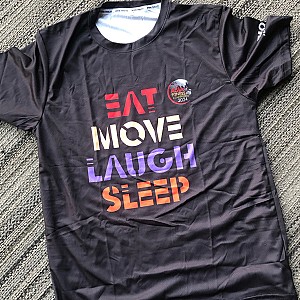
Asia Fitness Conference: A Cornerstone in My Career Development
Gregor Rasp , Thailand Oct 22, 2024 3
Last weekend, I attended the Asia Fitness Conference (AFC) in Bangkok, Thailand. This three-day event, which lasted from Friday morning to Sunday evening, was not just another conference for me—it was the 15th and final edition of an event that has profoundly shaped my professional journey. Having attended every single AFC since its inception in 2009, this year's farewell left me feeling both nostalgic and deeply grateful for the experience.
Global Fast Fit at AFC
For the first time this year, Global Fast Fit (GFF) debuted at the Asia Fitness Conference with a booth promoting their brand and introducing the GFF Routine of exercises to a broader regional public. The highlight was a competitive challenge, where delegates could test themselves by performing the routine and seeing their names displayed on a leaderboard. This element of friendly competition drew a lot of attention, keeping the booth buzzing with activity throughout the weekend. More importantly, the GFF team made several valuable connections that could play a key role in expanding GFF's presence in the Asian fitness market.
A Global Gathering with a Local Heart
AFC has always been an incredible melting pot of cultures, ideas, and innovation. Over the years, I've met delegates from across Asia and beyond, with some enthusiasts even traveling from Europe and the U.S. to take part. The conference is a regional platform that introduces the latest trends in fitness while celebrating diversity within the field.
Although the conference attracts professionals from many parts of Asia, it also highlights Thailand's importance in the regional fitness community. Most presenters travel from the U.S., Australia, and even New Zealand to teach at AFC. Lately, several presenters have come from local fitness centers and universities, demonstrating how the country has evolved into a fitness innovation and wellness hub. This combination of international and local expertise makes AFC truly exceptional.
The Workshops: A Glimpse into Fitness Trends
AFC offers various workshops each year, and this edition was no different. Whether it was cutting-edge training methods, yoga, pilates, or the latest dance choreography, the sessions provided a feast for any fitness professional eager to stay ahead of industry trends.
While I didn't participate in any of the dance or choreography sessions (not my cup of tea), I couldn't help but be impressed by how these workshops fostered creativity and enthusiasm among the participants. It wasn't just about learning; it was about connecting with the joy of movement, which is at the heart of the fitness world.
The Lectures: A Haven for Science Nerds
The Asia Fitness Conference isn't only about practical workshops; it's also a haven for people like me who thrive on the science behind exercise and fitness. As a self-proclaimed science nerd, I've always gravitated toward lectures on exercise science, behavioral science, and sports nutrition. These sessions were taught by some of the most respected lecturers in the field, many of whom also work as university professors, researchers, or coaches for elite athletes. Over the years, a few of these presenters even became personal mentors, influencing the direction of my career as a running and trail running coach.
The knowledge I gained from these lectures was invaluable. Whether it was better understanding metabolic processes, optimizing nutrition for endurance athletes, or learning how behavioral science could motivate clients, AFC has provided me with tools that have enriched my coaching practice. What stood out for me was the rigor and depth of the lectures. Many speakers brought real-world experience combined with academic research, ensuring the insights shared were grounded in science and practice.
Friendships, Mentorships, and Unforgettable Memories
It's impossible to reflect on AFC without acknowledging the personal connections I made. Over the past 15 years, I've formed friendships that transcend professional boundaries. AFC wasn't just a conference; it was a community. We bonded and laughed during the traditional Saturday Night Party, debating sports nutrition's finer points during lecture breaks. Some of these individuals became mentors, while others became lifelong friends.
These connections played a crucial role in shaping me into the coach I am today. AFC allowed me to network with some of the brightest minds in fitness and exercise science, who were generous with their time and expertise. I wouldn't be where I am today without these relationships, and I am eternally grateful for that.
A Vital Source for Continuing Education Credits
AFC has been crucial in maintaining my professional certifications by providing the continuing education credits required for renewal. The wide range of workshops and lectures at the conference kept me up-to-date with the latest trends and scientific advancements, ensuring I earned the necessary credits to stay certified. This annual opportunity for professional development has been an essential part of my growth as a running and trail running coach, allowing me to continue delivering the best for my clients.
The Impact on the Fitness Industry in Asia
Beyond my personal journey, AFC has had a lasting impact on the fitness industry in Asia. It has been a platform for education, innovation, and connection for professionals across the region. Over the years, it has helped elevate fitness education standards. It has undoubtedly influenced countless careers, businesses, and fitness trends.
In a region where the fitness industry is still growing, AFC was a vital source of knowledge and a key driver in helping fitness professionals push the envelope in their respective fields.
The Final Chapter: Saying Goodbye
It's hard to believe this year's AFC was the last of its kind. The event had a bittersweet atmosphere, knowing we were part of a closing chapter in regional fitness history. However, I'm choosing to focus on the legacy AFC leaves behind—the knowledge, the friendships, and the professional growth it fostered in all of us.
While it's sad to say goodbye to this chapter of my professional life, the lessons I've learned over the past 15 years will stay with me forever. AFC was more than just an event; it was a catalyst for personal and professional transformation, and I'm thankful to have been part of it.
As I progress in my career as a running and trail running coach, I will continue to embody the spirit of AFC. The lessons learned, the connections made, and the passion for athleticism it ignited in me will forever be a part of my journey. And for that, I will always be grateful.
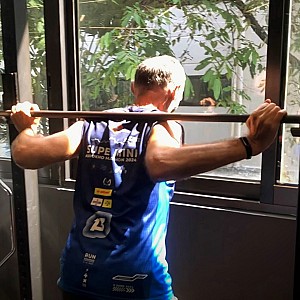
At 66, Strength Training is My Path Back to Trail Running
Gregor Rasp , Thailand Oct 07, 2024 1
Today is a special day for me—I'm about to step into my first strength training session with a professional coach. As a 66-year-old who's survived a decade-long battle with illness, this moment feels like the start of a new chapter in my life. After a decade of being unable to run, I'm finally ready to hit the trails again. But before diving deep into trail running, I must prepare my body and seriously rebuild my strength.
Why Hire a Strength Coach When I'm One?
Strength for Trail Running: Why It's Essential
Investing in Long-Term Success
Building Toward a Stronger Future
Final Thoughts
The Role of Global Fast Fit: A Foundation for Fitness
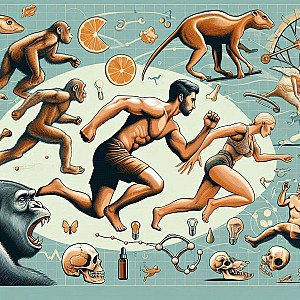
Why Do We Avoid Physical Activity? A Look at Our Evolutionary Heritage
Gregor Rasp , Thailand Sep 23, 2024 1
Humans have evolved to be active creatures, shaped by millennia of movement and survival. Yet, despite this evolutionary background, many of us today lead sedentary lifestyles. Why do we often avoid physical activity, even though it's essential for our health? To understand this, we must examine our evolutionary history and the biological forces that shaped our bodies and behaviors.
Renowned anthropologists Herman Pontzer and Daniel Lieberman have conducted groundbreaking research on human energy expenditure and evolutionary adaptations. Their work offers key insights into why we might be inclined to avoid exercise despite its benefits in the modern world.
Pontzer’s Research: The Constrained Energy Model
Pontzer’s research, particularly his work on energy expenditure, has reshaped our understanding of human metabolism. Contrary to traditional views, Pontzer discovered that while humans are indeed more active than most other primates, the amount of energy we expend through physical activity is not as variable as once believed. His "constrained energy model" suggests that, regardless of how active we are, our bodies adjust overall energy use to remain within a narrow range. This efficiency in energy use, though advantageous for survival, may reduce the perceived benefit of physical activity in the short term, making it harder to stay motivated to exercise.
Lieberman’s Research: Built for Endurance, Not Bursts
Lieberman focuses on how evolutionary pressures shaped human bodies for endurance and consistent, moderate activity, like that of our hunter-gatherer ancestors. He argues that humans are not naturally adapted for high-intensity, short-duration exercise (like modern gym workouts) but rather for activities spread throughout the day. His research suggests that our ancestors engaged in long bouts of walking, light running, and other moderate activities necessary for foraging and hunting. This could explain why intense, modern workouts may feel unnatural or daunting to many.
The Evolutionary Roots of Sedentary Behavior
When we combine these two perspectives, a clearer picture emerges. Pontzer’s research emphasizes our bodies' efficiency in conserving energy, even during moderate physical activity. This may reduce the motivation to exercise because we might not feel like we're expending enough energy to make the effort worthwhile. Lieberman's work, on the other hand, highlights how our bodies are built for sustained, low-to-moderate intensity movement throughout the day, not the intense, short bursts common in many fitness regimes.
Together, these insights suggest that our modern aversion to physical activity is not a sign of laziness but rather a reflection of our evolutionary design. Our bodies evolved to balance energy expenditure carefully, avoiding unnecessary exertion to conserve resources. In an environment of food scarcity, this was critical to survival. However, this predisposition can lead to sedentary behavior and poor health in today’s world, where food is abundant for most people and physical activity is often optional.
Rethinking Exercise for Modern Life
Understanding these evolutionary factors can help us rethink our approach to exercise. Awareness is the first step toward developing strategies that align more closely with our natural tendencies. If the usual modern fitness routines discourage you, find out what works. Perhaps try this:
-
Instead of focusing solely on intense, short workouts, engage in consistent, moderate activity throughout the day, like walking or cycling.
-
Incorporate movement into daily routines, such as standing while working or taking regular breaks to move around, as our ancestors likely did. For more ideas, check out Don't Sit, Get Fit by The University of New Mexico’s exercise science department.
-
Try exercise snacking. The Cleveland Clinic defines exercise snacking as a brief high-intensity movement or exercise that typically lasts no more than two minutes. And it’s something that you can and should do at various points in your daily life.
Our bodies are energy-saving machines designed to keep us going for as long as possible. We should concentrate on long-term health benefits instead of getting discouraged when we don’t see immediate results from our workouts.
Overcoming Evolutionary Barriers to Stay Active
By acknowledging our evolutionary heritage, we can better appreciate the importance of physical activity in modern life and work towards overcoming our natural tendencies toward inactivity. This understanding can help us develop healthier habits and improve our overall well-being.
More Resources
-
Lieberman, D. E. (2013). The story of the human body: Evolution, health, and disease. Pantheon Books.
-
Lieberman, D. E. (2020). Exercised: Why Something We Never Evolved to Do Is Healthy and Rewarding. Pantheon Books.
-
Pontzer, H. (2021). Burn: New research blows the lid off how we really burn calories, lose weight, and stay healthy. Avery.
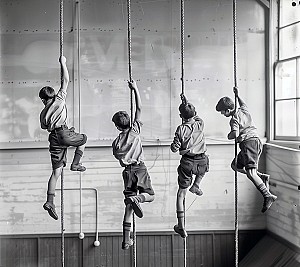
The Importance of Physical Activity for All Ages
Gregor Rasp , Thailand Sep 09, 2024 2
Physical activity is more than just looking good in a swimsuit (although that can be a perk!). It’s a cornerstone of a healthy lifestyle, offering numerous benefits for people of all ages. Whether you’re a young adult, middle-aged, or a senior, incorporating regular physical activity into your routine can significantly enhance your quality of life and your healthspan—healthspan is the number of years you are healthy, without chronic and debilitating disease (read more about the healthspan concept in this article in Fortune). Let’s explore why physical activity matters.
Benefits for the General Population
According to the Centers for Disease Control and Prevention (CDC), physical activity can help prevent chronic diseases such as heart disease, stroke, type 2 diabetes, and even some cancers. It can also help maintain a healthy weight, boost energy levels, reduce blood pressure, and improve sleep.
In addition, regular physical activity:
- Enhances Mental Health: Exercise releases endorphins, which are natural mood lifters. It can help reduce symptoms of depression and anxiety and improve overall mental well-being.
- Boosts Immune Function: Regular physical activity can enhance your immune system, making you less susceptible to illnesses.
- Increases longevity and healthspan: Studies have shown that regular physical activity can add years to one's life by reducing the risk of chronic diseases.
Physical Activity for Older Adults
As we age, staying active becomes even more important. Physical activity can help older adults maintain independence and improve overall quality of life.
According to the CDC, physical activity can help older adults:
- Prevent Chronic Diseases: Regular exercise can help prevent or manage chronic conditions like heart disease, diabetes, and arthritis.
- Improve Mobility and Balance: Activities like walking, yoga, and strength training can improve balance and coordination, reducing the risk of falls—a major concern for older adults.
- Enhance Cognitive Function: Physical activity has been shown to reduce the risk of cognitive decline and diseases like Alzheimer’s.
- Maintain Muscle Mass and Bone Density: Strength training exercises help maintain muscle mass and bone density, which are crucial for mobility and overall health.
- Boost Mental Health: Staying active can help reduce feelings of depression and anxiety.
Getting Started with Physical Activity
The good news is that you don't need to become a gym rat to reap the benefits of physical activity. Even small amounts of exercise can make a big difference.
If you're new to exercise, it's essential to start slowly and gradually increasing the intensity and duration of your workouts. Before starting any new exercise program, speak with your doctor.
Here are some tips:
- Start Slow: Begin with low-intensity activities like walking or gentle stretching, gradually increasing the intensity and duration.
- Find Activities You Enjoy: Whether it’s dancing, swimming, or gardening, choose activities that you find enjoyable to stay motivated.
- Set Realistic Goals: Set achievable goals and track your progress to stay motivated.
- Incorporate Variety: Mix different activities to work on various aspects of fitness, such as strength, flexibility, and endurance.
- Stay Consistent: Consistency is the key to a successful exercise regimen, so make sure to exercise regularly.
Physical Activity Recommendations
The CDC recommends that adults aim to get at least 150 minutes of moderate-intensity aerobic activity or 75 minutes of vigorous-intensity aerobic activity each week. They also suggest including strength-training exercises that target all major muscle groups at least twice a week. For older adults, it's recommended to include activities that improve balance, such as standing on one leg.
Going beyond the recommended guidelines can lead to even greater health benefits.
In this context, take a look at the Global Fast Fit (GFF) routine, as it already checks many of the boxes. How many boxes you check depends on how vigorously and often you perform the GFF exercises.
Remember, any amount of physical activity is better than none. So get out there and move! Your future self will thank you for it.
Takeaway
Physical activity is crucial for maintaining health and well-being at any age. It provides numerous benefits, from improved cardiovascular health to enhanced mental well-being for everyone. For older adults, staying active is essential to prevent chronic diseases, maintain mobility, and improve cognitive function. So, get up and get moving to enjoy a healthier, happier, and longer life!

Aim for Personal Excellence Instead of Trying to Be on Top
Gregor Rasp , Thailand Sep 03, 2024
In a world that often emphasizes being the winner, it is easy to lose sight of what truly matters. Being at the top isn't the most important thing. What truly matters is doing your best and striving to be the best version of yourself.
Rather than constantly comparing ourselves to others—a source of frustration and self-doubt—focus on personal excellence. Doing your best in every situation allows you to grow and improve without the burden of seeking external validation.
Step out of your comfort zone
To be your best self, challenge yourself, learn from experiences, and step out of your comfort zone. This means being self-aware, setting high standards, and aiming for continuous progress. When you commit to this, you grow personally and inspire those around you, creating a ripple effect of motivation.
There is more than just victories
Sure, winning a competition can be fun and rewarding, but success isn't just about victories. For most of us, there's always someone stronger, faster, or younger. Accept that reality and focus on your effort. When you've given your best, there's no room for disappointment, regardless of the outcome.
Check your motivation
If you're always driven to be the winner, regardless of effort, take a moment to check your motivation. Are you striving for self-improvement, or are you seeking recognition from others? If it's the latter, fulfillment and happiness might be elusive. After all, only one person can win a competition, but everyone can strive to be their best.
Takeaway
So, instead of aiming to be on top, focus on being the best you can be in every aspect of your life. True success, which brings lasting satisfaction, lies in personal fulfillment, growth, and knowing you gave your all. As the saying goes, "It's not about being the best; it's about being your best."
Consider the concept
Granted, this may sound very idealistic, and it is. Daily life is often more nuanced, so don't stress yourself over it. However, it's worth considering this concept. Reflect on your motivations and behaviors from time to time. Try it, and you may find value and fulfillment in striving to be the best version of yourself as often as possible.
Actionable advice
To start embracing the mindset of personal excellence, begin by setting small, achievable goals that focus on self-improvement rather than comparison with others. For example, instead of aiming to outperform a colleague, set a goal to enhance a specific skill or habit each week. Celebrate your progress, no matter how small, as this reinforces the value of personal growth. Regularly reflect on your motivations—ask yourself if you're driven by a desire to improve or the need for external validation. By making these small adjustments, you'll gradually shift your focus toward becoming the best version of yourself. It takes practice, so be patient.

Perfect Form: The Key to Effective and Safe Workouts
Gregor Rasp , Thailand Aug 27, 2024 1
I apologize for any confusion my recent blog post may have caused. Let me clarify my stance on proper exercise form.
When it comes to exercising, it's not just about how hard you work but also how you perform an exercise. Without proper exercise form, workouts can lead to injuries or wasted effort. Let’s clear up any confusion and dive into why perfect form is key to achieving your fitness goals.
What is Perfect Form?
Perfect form means executing a movement safely, effectively, and efficiently within the constraints of an exercise. It involves:
- Proper body and limb alignment: Ensuring your body is positioned correctly for each exercise.
- Controlled movements: Moving with intention, avoiding jerky or rushed motions.
- Proper movement sequence: Ensuring you follow the correct sequence of joint movements, including the direction of the movements.
- A solid mind-muscle connection: Focusing on the targeted muscles ensures they are engaged throughout the exercise.
Each exercise targets particular muscles and involves a specific sequence of joint movements, including the direction of movement and body positioning. By mastering these aspects, you can maximize your workout efficiency and results.
Individual Differences
Individual differences play a significant role in determining what constitutes perfect form. These differences and limitations vary greatly from person to person, so there's no one-form-fits-all approach. Instead, achieving the best possible form within your abilities is the goal. It ensures you target the right muscles, prevent injuries, and maximize results. So when I say 'perfect form,' I mean optimal form, given one’s unique circumstances.
Certain limitations may restrict the types of exercises an individual can safely perform or the amount of weight they can lift. Understanding and respecting these differences is crucial for any effective workout.
Form Variations
Adjusting your grip width or type when using a barbell doesn’t usually compromise perfect form. Instead, it helps target different muscle fibers or challenges the same fibers in new ways within a given muscle or muscle group. The same applies to varying stance width, using limited ranges of motion, playing with different execution speeds, or making other adjustments within the definition of a given exercise.
For instance, narrowing your grip during a bench press shifts more emphasis onto the triceps (there may be better exercises for developing the triceps), while a wider grip targets the chest muscles more. Such variations keep your workouts fresh and ensure balanced muscle development. When done with proper form, exercise variations can be a powerful tool for progressing or regressing any exercise as needed.
Why is Proper Form Important?
Proper form is crucial for several reasons:
- Injury Prevention: Correct form helps protect joints, ligaments, and tendons from strain or injury.
- Enhanced Results: Good form ensures the targeted muscles are effectively worked, leading to optimal results.
- Better Movements: Mastering proper form can lead to more efficient and graceful movements.
- Lifting Heavier: Proper form allows you to lift heavier weights safely, improving outcomes.
- Performing the Intended Exercise: Not following proper form can result in performing a completely different exercise than intended, reducing effectiveness.
Tips for Improving Form
Mastering proper form takes time and consistent practice. Here are some tips to help you improve:
- Learn Proper Technique: Watch instructional videos or consult a fitness professional—especially recommended for lifting weights.
- Start with Bodyweight Exercises: Focus on form before adding more resistance (weight).
- Use a Mirror: Observing yourself in a mirror can help identify any form errors.
- Be Patient: Mastering form takes time, and consistency is key. Pay attention to any pain or discomfort that could indicate incorrect form. If unsure, ask a qualified fitness professional for help.
Takeaway
Perfect form isn't about achieving perfection; there's no one-form-fits-all; it's about doing the best with what your circumstances allow. It's about mastering an exercise in how it should be performed for safety and optimal results. Focus on form, and the results will follow.
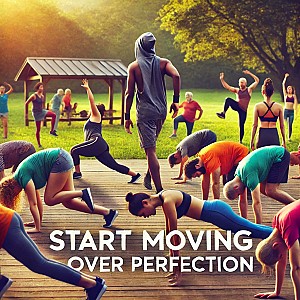
Get Moving: Getting Started Matters More Than Perfect Form
Gregor Rasp , Thailand Aug 20, 2024 2
In the fitness world, there's a long-standing emphasis on achieving perfect form when exercising, and for good reason—perfect or near-perfect form minimizes the risk of injury and maximizes the benefits of the exercise. However, when it comes to getting people moving, especially those who have mainly led sedentary lives, the need for flawless execution may be relaxed when bodyweight exercises are concerned.
Bodyweight exercises
What are bodyweight exercises? Bodyweight exercises are strength training exercises that use your body weight as resistance against gravity. This means you don't need special equipment like weight plates, dumbbells, or machines to perform them.
Common bodyweight exercises include push-ups, squats, planks, leg raises, and glute bridges. While these exercises can be more forgiving and pose less risk when performed with imperfect form, it's still essential for everyone to strive for proper form, even with bodyweight exercises. Without correct form, you will not develop the strength you are after with a specific exercise.
Starting with lighter variations or modifications and gradually progressing can help ensure correct technique, reduce the risk of injury, and enhance long-term benefits.
❝ If we had one public health intervention that would benefit a population the most, it would be exercise. Encouraging the population to exercise is crucial as it has tons of benefits. ‒ paraphrased from Professor Paul D. Thompson [1]
Global Fast Fit exercises
I noticed that with Global Fast Fit, individuals often believe they're performing a specific exercise, but due to incorrect form, they are actually doing a different exercise altogether. Instead of push-ups, they might do pelvic tilts; leg raises become leg curls, and squats turn into VMO dips.
Without correct form, you will not see the desired results. VMO dips and leg curls do not build the quad and glute strength that squats and leg raises do, and pelvic tilts certainly do not build chest strength.
Global health crisis
Considering the current health crisis, particularly in the Western world, where sedentary lifestyles are alarmingly common, getting people to move has become increasingly important. Working out regularly is the goal, even if you end up doing a different move than the one you were supposed to do. Any initiative encouraging large numbers of people to ditch their couches and start exercising is a win. An example of such an initiative is Global Fast Fit.
Starting with basic, accessible exercises can act as a gateway for many. It’s like tasting sugar for the first time (or, more realistically, breaking a sweat). That initial taste of physical exertion can lead to greater things. Hopefully, the experience will ignite a passion for fitness for some, motivating them to refine their form and progress to more advanced exercise regimens. It’s a stepping stone, not the final destination.
A positive feedback loop
Moreover, many people who start exercising gradually begin to make healthier choices in other areas of their lives, particularly with their diets. Exercise tends to foster a positive feedback loop—once people start moving, they begin to feel better, and that good feeling often leads them to seek out even more ways to improve their health.
Building a habit of regular movement
Not everyone is an athlete or a fitness enthusiast who doesn’t need motivation. For some individuals, simply getting up and moving is a significant first step towards a healthier lifestyle. The less-than-perfect form may be tolerated initially, as the focus is on building the habit of regular movement.
Takeaway
So, while perfect form is crucial in many contexts, the bigger picture tells us that the most important thing is getting people to start moving. Once they do, the journey towards better health, both in terms of exercise and diet, often follows naturally. Let’s celebrate movement as a step in the right direction.
Warning: Perfect form is crucial When lifting weights, whether with a barbell or free weights. If you don't apply proper form, you could get seriously injured.
References
[1] McConell, G. (Host). (2024, August 19). #87 - Exercise and sports cardiology with Professor Paul D. Thompson [Audio podcast]. Retrieved from https://www.listennotes.com/podcasts/inside-exercise/87-exercise-and-sports-6u29doFzk1G/
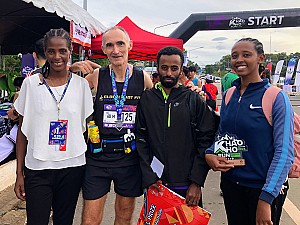
Racing at Dawn: The Ultimate Weekend Escape
Gregor Rasp , Thailand Aug 13, 2024 2
When most people think of a fun weekend, they might picture a relaxing getaway, leisurely brunches, or maybe even a spontaneous road trip. Our idea of fun is a little different.
Last weekend kicked off on Friday evening with an overnight bus ride that got us into town at 3 AM Saturday. Groggy but excited, we headed straight to a hotel for a quick five hours of sleep. It’s not much, but just enough to recharge before the real adventure begins.
By Saturday mid-morning, we were up again and heading to the race venue. There’s something electrifying about picking up the race pack and mingling with fellow athletes and acquaintances with the same crazy passion.
After that, it was time to fuel up with some good food and grab another nap. We’ll need all the rest we can get because the next wake-up call will come at 2 AM.
Come Sunday morning, before dawn breaks, the alarm jolted us awake. It’s race day, and we’ve got to be ready for the 4 AM start. The gun goes off, and there we are, running up and down a 4-lane highway while most of the world is still fast asleep.
It’s not just a race; it’s a lifestyle—a test of determination, endurance, and certainly a lot of madness. For us, there’s no better way to spend a Sunday morning.
After crossing the finish line and sharing war stories with fellow runners, perhaps picking up a trophy, as in the case of my sweet wife, it’s back to the hotel for a well-deserved meal and some serious downtime.
The rest of Sunday was dedicated to sleep and recovery before catching another overnight bus home. When we finally arrived on Monday morning, it was time for more eating, more sleeping, and that sense of victory after crushing another challenge.
Sure, this kind of weekend isn’t for everyone, but for us, it’s the perfect blend of challenge, excitement, and satisfaction.
The key question is whether it’s worth all of this for a few hours on a nearly deserted up-country highway between night and sunrise—the answer is always yes for us. We love pushing ourselves beyond our comfort zones.

Is salt bad for you?
Gregor Rasp , Thailand Aug 07, 2024 2
I am not a trained nutritionist, just a certified strength and conditioning specialist and personal trainer. So, please take my ensuing rant with a grain of salt.
Salt, or sodium chloride (short: sodium), is one of two essential electrolytes. The other is potassium, which works in tandem with sodium (sodium-potassium pump). Both are crucial for our health and well-being.
Is salt bad for you?
Salt is not inherently bad for you—the same goes for sugar, by the way; a topic for another day.
Since humans first appeared on this planet, salt has been essential to our diets. Salt/sodium is necessary for many body processes, such as nerve transmission, blood pressure regulation, and fluid balance maintenance.
Excessive salt intake can be harmful—and again, the same goes for sugar—In sensitive individuals, high amounts of salt can lead to high blood pressure.
However, what is considered too much depends on each person’s circumstances and health status. As with almost everything health and fitness-related, context matters a lot.
Recommended daily intake
According to the American Heart Association, no more than 2,300 mg (or roughly one teaspoon) of sodium should be consumed daily. That being said, 1,500 mg per day is the optimal daily limit for most adults. Health authorities across nations generally advise similar amounts.
Diet
Processed foods are the main source of salt in a typical Western diet. These foods usually have high sodium levels to boost flavor and extend shelf life.
When we talk about processed foods, think of ready meals, fast food, deli meats, cold cuts, salty snacks like chips and pretzels, sauces, condiments, etc. If you eat these foods regularly, adding extra salt to your diet isn't necessary and can actually be harmful.
I personally steer clear of overly processed foods and rarely add extra salt to my meals.
Worried?
Don't eliminate salt entirely. Maintaining excellent health requires striking the correct balance.
Consult with a healthcare professional if you have concerns about your sodium intake or blood pressure. A doctor or registered dietitian can offer personalized advice.
Conclusion
By making smart choices and understanding the role of salt in your diet, you can enjoy the benefits of this essential mineral while keeping your health in check.
Sources of my knowledge
I like to get my information from scientific papers or nutritionists, usually through podcasts or at conferences. Whenever I'm uncertain about something, I always double-check using a reliable source.

The Bright Side of Adversity: How I Learned to Thrive Despite It
Gregor Rasp , Thailand Aug 07, 2024 2
After my cycling accident, I woke up in the ICU from a 17-day coma and realized everything had changed. I had lost about 15 kg (33 lbs), dropping from 75 kg (165 lbs) to 59 kg (132 lbs). Since I was in good shape before, most of that weight loss was muscle, not fat. In other words, there wasn't much left of me, and my fitness had vanished along with the kilos (pounds). I could barely move my arms and was so weak that I needed help with everything, even holding a spoon.
No grudges
Interestingly, I wasn't upset about my situation and didn't hold any grudges against the drunk driver who hit me front-on in broad daylight. It is what it is, and I must deal with it to move forward.
Blame is unproductive; my energy is better spent on recovery and rebuilding.
I had two options: I could either be miserable and angry every day, or I could make the best of it, be happy to be still alive, and see what I could do to recover, regain strength, and get out of the hospital.
One tiny step at a time
Determined to regain my strength, I had to start small, initially using the TV remote as a makeshift weight. Working with the hospital's physiotherapists, we came up with a plan that I followed diligently (being a certified personal trainer helped!), only skipping workouts when I was too tired and needed rest. That’s how I began my journey back to fitness, one tiny step at a time.
After 63 days in the hospital, I was finally discharged, somewhat fit for daily life. However, I still needed a lot of training to return to a reasonable functional level (again, being a certified personal trainer helped!). Athleticism would be out of the picture for a while—now, after a decade and several more obstacles, I am finally picking it up again.
A fundamental lesson
I had just learned a fundamental life lesson that set me on the path to fulfillment and happiness (I still follow it): always look on the bright side, focus on what you have rather than what you’ve lost, and make the best of every situation. Maybe I’m privileged to see opportunities where others see obstacles, no matter how adverse things get.
Taking on Global Fast Fit: Greg's Story
Finding Strength in the Struggle: A Story of Recovery and Resilience
 Login with Google
Login with Google